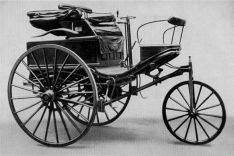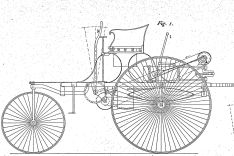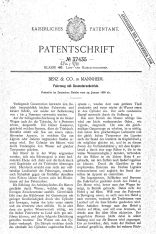Content
First car journey in the world

With hatpin, garter and 3 hp: Bertha Benz drives into the automotive age
On 5 August 1888, a woman ushered in the age of the automobile: without Bertha Benz, the history of mobility would have been very different. On this day, she undertook the first long journey in a motor vehicle. In doing so, she proved to her husband and the rest of the world that her invention was suitable for everyday use and had the potential to change everything.
Almost two years earlier, on 2 November 1886, Carl Benz had been granted a patent by the Imperial Patent Office, the forerunner of the DPMA, for his " ![]() Fahrzeug mit Gasmotorenbetrieb " (file vehicle with gas engine Operation) with retroactive effect from 29 January 1886 - the first automobile with an internal combustion engine. Incidentally, patent specification "No. 37435" is now part of
Fahrzeug mit Gasmotorenbetrieb " (file vehicle with gas engine Operation) with retroactive effect from 29 January 1886 - the first automobile with an internal combustion engine. Incidentally, patent specification "No. 37435" is now part of ![]() UNESCO´s Memory of the world collection and can of course also be found in the DPMA's poster gallery of inventions .
UNESCO´s Memory of the world collection and can of course also be found in the DPMA's poster gallery of inventions .
175th birthday
She was far more than just the world's first female motorist: Bertha Benz, the technically adept and courageous pioneer of mobility, opened up a new era. Her husband Carl did not have as much confidence in his own invention as she did: "She was more daring than me and undertook a journey that was decisive for the further development of the motor car," Carl Benz later confessed. Bertha said modestly about her historic journey: "I was the first to show that "Papa" could drive his car long distances." Bertha Benz, who showed the world the possibilities of the automobile, was born 175 years ago on 3 May 1849 in Pforzheim. She died 80 years ago on 5 May 1944 in Ladenburg.
Benz had already undertaken a first short public test drive with his "No. 1" on 3 July 1886. Although the local press reported on the invention, the hoped-for response failed to materialise; there was little interest in the "horseless carriage" as it was not considered suitable for practical use. It took the courage of Benz's wife to prove to the world what the (further developed) "Benz Patent Motor Carriage No. 3" could do.
On that August morning 136 years ago, Bertha Benz set off from Mannheim at the crack of dawn with her sons Eugen and Richard (aged 15 and 13). Without the knowledge of her husband, who would never have allowed this journey due to his uncertainty, they travelled around 100 kilometres to Bertha's home town of Pforzheim in the three-wheeled motor carriage to visit their mother.
Incidentally, Bertha Benz did not have a driving licence. A few days earlier, her husband had received the world's first driving licence, issued on 1 August 1888 by the Grand Ducal-Baden District Office. Bertha didn't have to be afraid of the traffic police, however, as they didn't even exist yet and it was her illegal driving that indirectly contributed to the development of a modern transport system with strict rules.
Blacksmith and pharmacist help out

Benz patented Motorised Carriage No. 3 from 1888
The circumstances and anecdotes surrounding the world's first large motor car are legendary:
How the town pharmacy in Wiesloch became the world's first petrol station, as Bertha Benz bought a few litres of Ligroin there, a cleaning agent that served as fuel for the small single-cylinder engine with its barely 3 hp.
How it came to minor breakdowns in between, which Bertha - the woman herself! - resourcefully repaired: she cleaned the clogged petrol line with her hatpin; she repaired the ignition with her garter. A village blacksmith helped her mend the chain, thus opening the first car repair shop.
How they had to scoop up cooling water every few kilometres, from wells, pubs, ditches - whatever. And how a cobbler nailed new leather caps onto the brake pads.
How passers-by reacted with fear and astonishment to the unfamiliar vehicle, how horses ran through and oxen shied away. How the three runaways occasionally sent telegrams to Carl Benz to reassure him and report the success of the journey. How they sometimes had to push uphill, as the car did not yet have a suitable gear ratio.
The third gear

Drawing from patent specification DE 37435
Incidentally, Bertha suggested the introduction of a third gear on the basis of this experience. Carl Benz implemented the idea; and when the worldwide triumph of automobiles began - all now with a third gear - Bertha was very proud that she had provided the impetus.
The almost 13-hour journey from Mannheim to Pforzheim and back (today the „![]() Bertha Benz Memorial Route“) showed that the automobile was practical. Above all, however, it encouraged the self-doubting Carl Benz to believe in his invention again: "She was more daring than me and undertook a journey that was decisive for the further development of the motor car," he later recalled. Now he once again did everything he could to help his car achieve a breakthrough. This was achieved with the presentation at the Munich "Kraft- und Arbeitsmaschinenausstellung" in the same year and the World Exhibition in Paris in 1889.
Bertha Benz Memorial Route“) showed that the automobile was practical. Above all, however, it encouraged the self-doubting Carl Benz to believe in his invention again: "She was more daring than me and undertook a journey that was decisive for the further development of the motor car," he later recalled. Now he once again did everything he could to help his car achieve a breakthrough. This was achieved with the presentation at the Munich "Kraft- und Arbeitsmaschinenausstellung" in the same year and the World Exhibition in Paris in 1889.
The rest is history: the "Benz Patent-Motorwagen No. 3" was built in series and offered for 3000 gold marks. The "Benz & Cie. Rheinische Gasmotorenfabrik Mannheim", later "Benz & Cie. AG", was the largest automobile factory in the world in 1900 and later merged into corporations that still exist today.
Mother, encourager, patron
The ![]() Science Museumi n London houses a Benz Patent Motor Car No. 3, which is possibly the oldest surviving car and perhaps the very vehicle in which Bertha made her legendary journey. Benz's first automobile, the "No. 1", can be seen today at the DPMA's Munich neighbour, the
Science Museumi n London houses a Benz Patent Motor Car No. 3, which is possibly the oldest surviving car and perhaps the very vehicle in which Bertha made her legendary journey. Benz's first automobile, the "No. 1", can be seen today at the DPMA's Munich neighbour, the ![]() Deutschen Museum.
Deutschen Museum.
But Bertha Benz did not only write transport history with her historic journey. Without her, Carl would probably never have made his invention in the first place, or at least never have been able to bring it to market.
Born Cäcilie Bertha Ringer on 3 May 1849 in Pforzheim, Bertha came from a wealthy family. Always highly interested in technology, she decided against a "good match" with a financially secure future in favour of the young, breadwinning but visionary engineer Carl Benz. She had her dowry paid out in advance and invested it in his small company.
For many years, the ever-growing family with four children had to live partially on the breadline, as Benz remained unlucky as an entrepreneur. Bertha ran the household with iron thrift; every penny was invested in Benz's work. Without her, he would have been lost, as he later admitted in his memoirs: "Only one person stood beside me in the little ship of life in those days when things were going downhill. That was my wife. She bravely and courageously hoisted new sails of hope."
Late honours
The automobile company, which (also) goes back to Benz and today bears his name again, is one of the most important applicants for patents at the DPMA (Mercedes-Benz AG in second place in 2023, see our statistics). The company writes on its ![]() website that Bertha's capital and bravery played a key role in its success story: "The daring of Bertha Benz and her sons is one of the decisive impulses for the rise of Benz & Cie. in Mannheim to what was at times the largest automobile factory in the world."
website that Bertha's capital and bravery played a key role in its success story: "The daring of Bertha Benz and her sons is one of the decisive impulses for the rise of Benz & Cie. in Mannheim to what was at times the largest automobile factory in the world."
She proudly witnessed the worldwide triumph of the automobile. On her 95th birthday, Bertha Benz was made an honorary senator by the Technical University of Karlsruhe (where Carl had studied). She died two days later on 5 May 1944.
Text: Dr. Jan Björn Potthast; Pictures: Bertha Benz By Bühler, Mannheim (Automuseum Dr. Carl Benz, Ladenburg) [Public domain], via Wikimedia Commons, via Wikimedia Commons, DEPATISnet, bertha-benz.de Memorial Route
Last updated: 10 December 2025



Not only protecting innovations
Social Media